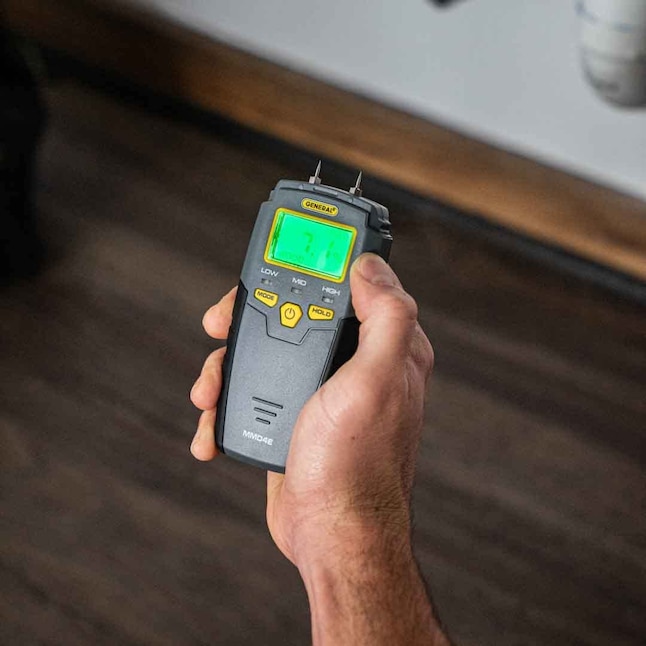Moisture Meter Buying Overview: What to Look for in High-Quality Instruments
Wiki Article
The Ultimate Overview to Moisture Meters: A Comprehensive Review and Just How They Can Conserve You Money
In the realm of building upkeep, building and construction, and numerous sectors, the relevance of properly determining wetness levels can not be overstated. Moisture meters work as crucial devices in spotting and keeping track of moisture content in products, assisting in protecting against pricey damages and making certain the quality of products. Understanding the nuances of various sorts of moisture meters, their applications, and the possible cost-saving benefits they offer can be a game-changer for professionals and organizations alike. Finding just how these gadgets can not just enhance processes however likewise add to monetary cost savings is a journey worth getting started on.Sorts Of Moisture Meters
One usual type is the pin-type moisture meter, which determines the electric resistance in between two pins inserted into a product. Pinless dampness meters, on the other hand, use electro-magnetic sensing unit plates to check a larger area without triggering damages to the material's surface area.Moreover, there are additionally specialized wetness meters designed for details products like soil, hay, or grain. These meters offer precise wetness analyses tailored to the distinct buildings of the material being tested. Infrared moisture meters measure the thermal homes of a material to identify its wetness material non-invasively, making them helpful for applications where pin or pinless meters may not be appropriate. Comprehending the various kinds of moisture meters available can help industries choose one of the most ideal device for their details dampness measurement requirements.

Benefits of Making Use Of Moisture Meters

Furthermore, using dampness meters can lead to raised power effectiveness. In agricultural settings, moisture meters play a crucial duty in maximizing plant yields by enabling farmers to monitor dirt dampness levels and make informed watering choices.
Exactly How to Choose the Right Moisture Meter
Picking the proper wetness meter includes considering essential elements such as material compatibility, dimension variety, and calibration precision. When selecting a moisture meter, it's essential to make certain that the meter is appropriate for the particular product you will be testing. Various materials have varying electric buildings that can impact moisture readings, so selecting a meter made for your material is crucial for precise outcomes. Furthermore, consider the dimension variety of the wetness meter. Ensure that the meter can find moisture degrees within the array required for your applications. Calibration precision is another important element to remember (Moisture Meter). Opt for a wetness meter with dependable calibration to make certain accurate and regular analyses. Some meters might require regular calibration changes, so understanding the calibration procedure is very important. By very carefully reviewing these elements, you can select a dampness meter that meets your requirements and gives accurate wetness dimensions for your projects.Proper Methods for Moisture Meter Use
To ensure precise dampness analyses and optimize the performance of a moisture meter, employing proper methods is necessary. When making use of a pin-type dampness meter, insert the pins or probes into the material being tested until they make full get in touch with. Make sure the pins are vertical to the surface to get the most accurate reading. For pinless wetness meters, hold the gadget flat against the material and relocate slowly to cover the whole location for my blog an ordinary reading. It's critical to adjust the dampness meter according to the product being checked to improve precision. Take several readings across the surface and average them out for a much more trusted outcome. Furthermore, make sure that the material being evaluated is adjusted to the environment to stop skewed analyses. Routine maintenance of the moisture meter, such as cleansing the pins or sensing unit, is likewise important to ensure precise and consistent analyses. By adhering to these appropriate techniques, users can count on their dampness meter to give trustworthy dampness degrees, aiding in preventing pricey damage or ensuring top quality in different applications.
Expense Savings Via Moisture Meter Applications
Exactly how can the tactical usage of dampness meters lead to significant expense financial savings across different sectors? In the agriculture industry, moisture meters aid in identifying the ideal time for collecting plants, protecting against excess or over-drying moisture that can impact the final product's quality.

Additionally, in the food processing market, moisture meters are important for keeping track of product quality and guaranteeing compliance with safety laws. By properly gauging dampness material in food products, producers can prevent spoilage, keep quality, and minimize waste, leading to significant cost financial savings. Generally, the calculated application of wetness meters is an important investment that can lead to considerable cost decreases and enhanced efficiency throughout different industries.
Final Thought
To conclude, moisture meters are beneficial tools for gauging and discovering moisture degrees in different products. By utilizing the appropriate wetness meter and following correct techniques, customers can successfully prevent pricey problems triggered by excess dampness. Investing in a quality wetness meter can lead to considerable cost savings in find more information the lengthy run by determining possible issues beforehand and allowing punctual remediation. Eventually, dampness meters are vital tools for preserving the honesty and longevity of materials and structures.Wetness meters serve as crucial tools in discovering and keeping track of moisture web content in products, aiding in avoiding expensive damages and making sure the top quality of items. Infrared dampness meters gauge the thermal residential properties of a product to establish its dampness web content non-invasively, making them useful for applications where pin or pinless meters may not be suitable.Moisture meters straight from the source offer important advantages in properly keeping track of and evaluating moisture levels in diverse materials and atmospheres. In agricultural settings, dampness meters play a crucial duty in maximizing plant yields by allowing farmers to keep track of soil dampness degrees and make notified irrigation decisions.In verdict, wetness meters are useful tools for spotting and measuring wetness levels in numerous products.
Report this wiki page